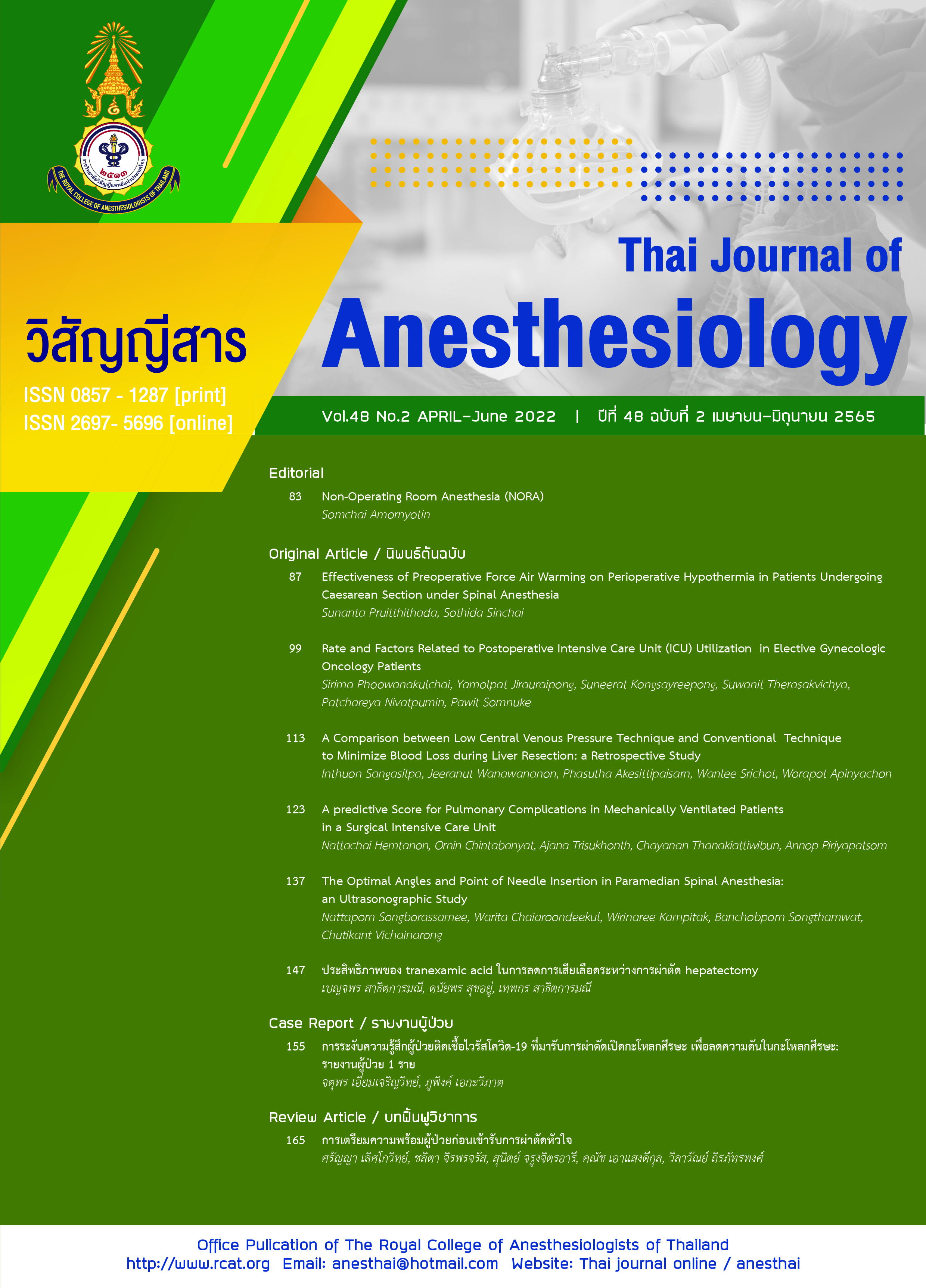The Optimal Angles and Point of Needle Insertion in Paramedian Spinal Anesthesia: an Ultrasonographic Study
Main Article Content
Abstract
Background: Multiple attempts at needle placement in conventional paramedian spinal anesthesia are still often required to reach the subarachnoid space in some individuals. This study aims to assess the optimal angles and point of needle insertion for spinal anesthesia using neuraxial ultrasound scanning. Method: Neuraxial ultrasound scanning of the L2-L5 intervertebral spaces in 120 volunteers aged 20-79 years was performed. The optimal vertical and horizontal angles were analyzed using the Arccosine function. The baseline characteristics, neuraxial structural depth, and optimal needle insertion point were evaluated in transverse midline (TM) and paramedian sagittal oblique (PSO) views from ultrasound scanning. Results: At 1 cm caudal to spinous process, mean optimal needle-entry angle was 18.6±5.2°, 18.5±5°, and 18.7±4.9° in PSO view and 25±6.2°, 25.7±6.3°, and 28.1±6.9° in TM view at L2/3, L3/4 and L4/5 intervertebral space, respectively. The distance from midline to lateral for paramedian needle insertion was 1.7±0.4 cm at both L2/3 and L3/4, and 1.8±0.4 cm at L4/5 intervertebral space. There was significant inverse correlation between maximal vertical angle, age, and BMI at L2-5 (P < 0.05). Conclusion: The optimal angles of needle trajectory range for paramedian spinal anesthesia were 13-25° vertically and 17-35° medially off the sagittal plane in L2-L5 levels, and optimal point for needle insertion was 1.7-1.8 cm lateral from midline. Increased age and high BMI were associated with unfavorable parameters which may result in difficult spinal anesthesia.
Article Details

This work is licensed under a Creative Commons Attribution-NonCommercial-NoDerivatives 4.0 International License.
References
Gropper MA, Miller RD. Miller’s Anesthesia, 2020, Philadelphia, PA: Elsevier, p.1429-30.
Tessler M, Kardash K, Wahba R, Kleiman S, Trihas S, Rossignol M. The performance of spinal anesthesia is marginally more difficult in the elderly. Reg Anesth Pain Med. 1999;24:126-30.
Ruzman T, Gulam D, Drenjancevic IH, Venzera-Azenic D, Ruzman N, Burazin J. Factors associated with difficult neuraxial blockade. Local Reg Anesth. 2014;7:47-52.
Kim JH, Song SY, Kim BJ. Predicting the difficulty in performing a neuraxial blockade. Korean J Anesthesiol. 2011;61:377-81.
Kang XH, Bao FP, Xiong XX, et al. Major complications of epidural anesthesia: a prospective study of 5083 cases at a single hospital. Acta Anaesthesiol Scand. 2014;58:858-66.
Chin KJ, Karmakar MK, Peng P. Ultrasonography of the adult thoracic and lumbar spine for central neuraxial blockade. Anesthesiology. 2011;114:1459-85.
Chin KJ, Ramlogan R, Arzola C, Singh M, Chan V. The utility of ultrasound imaging in predicting ease of performance of spinal anesthesia in an orthopedic patient population. Reg Anesth Pain Med. 2013;38:34-8.
Puigdellivol-Sanchez A, Reina MA, Sala-Blanch X, Pomes-Tallo J, Prats-Galino A. Pythagoras and cosines: the skin-dural sac distance and optimal angles in paramedian spinal anesthesia. Clin Anat. 2016;29:1046-52.
Chin KJ, Perlas A, Chan V. The ultrasound-assisted paraspinous approach to lumbar neuraxial blockade: a simplified technique in patients with difficult anatomy. Acta Anaesthesiol Scand. 2015;59:668-73.
Kampitak W, Werawatganon T, Uerpairojkit K, Songthamwat B. Paramedian spinal anesthesia: landmark vs. ultrasound-guided approaches. J Anesth Clin Res. 2018;9:1000837.
Srinivasan KK, Iohom G, Loughnane F, Lee PJ. Conventional landmark-guided midline versus preprocedure ultrasound-guided paramedian techniques in spinal anesthesia. Anesth Analg. 2015;121:1089-96.
Blomberg RG, Jaanivald A, Walther S. Advantages of the paramedian approach for lumbar epidural analgesia with catheter technique. A clinical comparison between midline and paramedian approaches. Anaesthesia. 1989;44:742-6.
Zhou Y, Chen W, Zhou S, Tao Y, Xu Z, Liu Z. Comparison of different approaches to combined spinal epidural anesthesia (CSEA) under the
guidance of ultrasound in cesarean delivery of obese patients: a randomized controlled trial. Eur J Med Res. 2021;26:106.
Vogt M, van Gerwen DJ, van den Dobbelsteen JJ, Hagenaars M. Optimal point of insertion of the needle in neuraxial blockade using a midline approach: study in a geometrical model. Local Reg Anesth. 2016;9:39-44.
Shankar H, Rajput K, Murugiah K. Correlation between spinous process dimensions and ease of spinal anaesthesia. Indian J Anaesth. 2012;56:250-4.
Park SK, Yoo S, Kim WH, Lim YJ, Bahk JH, Kim JT. Ultrasound-assisted vs. landmark-guided paramedian spinal anaesthesia in the elderly: A randomised controlled trial. Eur J Anaesthesiol. 2019;36:763-71.
Qu B, Chen L, Zhang Y, et al. Landmark-guided versus modified ultrasound-assisted paramedian techniques in combined spinal-epidural anesthesia for elderly patients with hip fractures: a randomized controlled trial. BMC Anesthesiol. 2020;20:248.
Narkhede HH, Kane D, Parekh V, Hemantkumar I. A cohort study of anatomical landmark-guided midline versus pre-procedure ultrasound-guided midline technique of spinal anesthesia in elderly patients undergoing orthopedic surgery. J Anaesthesiol Clin Pharmacol. 2019;35:522-7.
Sidiropoulou T, Christodoulaki K, Siristatidis C. Pre-procedural lumbar neuraxial ultrasound-a systematic review of randomized controlled trials and meta-analysis. Healthcare (Basel). 2021;9:479.
O’Donnell D, Prasad A, Perlas A. Ultrasound-assisted spinal anesthesia in obese patients. Can J Anaesth. 2009;56:982-3.
Li M, Ni X, Xu Z, et al. Ultrasound-assisted technology versus the conventional landmark location method in spinal anesthesia for cesarean delivery in obese parturients: a randomized controlled trial. Anesth Analg. 2019;129:155-61.
Sahin T, Balaban O, Sahin L, Solak M, Toker K. A randomized controlled trial of preinsertion ultrasound guidance for spinal anaesthesia in pregnancy: outcomes among obese and lean parturients: ultrasound for spinal anesthesia in pregnancy. J Anesth. 2014;28:413-9.
Canturk M, Kocaoglu N, Hakki M. Preprocedural ultrasound estimates of epidural depth: transverse median plane is comparable to paramedian sagittal oblique plane in non-pregnant patients. Turk J Anaesthesiol Reanim. 2020;48:31-7.
Salman A, Arzola C, Tharmaratnam U, Balki M. Ultrasound imaging of the thoracic spine in paramedian sagittal oblique plane. Reg Anesth Pain Med. 2011;36:542-7.
Kim Y, Yoo S, Park SK, Bae H, Lim YJ, Kim JT. Optimal angle of needle insertion for spinal anesthesia in patients with spondylolisthesis: an ultrasonographic study. BMC Anesthesiol. 2021;21:221.


